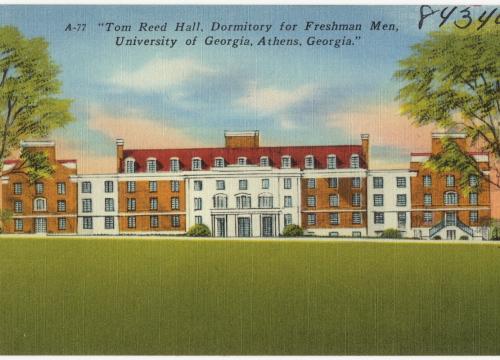Reed Hall – UGA 280 (1953, Category 2). Reed Hall was built in 1952, one of two buildings erected during the early 1950s adjacent to existing buildings to help form residence-hall quadrangles. The other was Myers Hall. It was named for Registrar Thomas E. Reed, class of 1888, who served as a university administrator for nearly 40 years.
Reed and Myers Halls were constructed to address an acute shortage of on- campus housing after World War II. Their construction began a program of gradual improvement of facilities throughout the campus under the newly created University System Building Authority. Both buildings were designed by engineering professor Robert Driftmier and architect Roy Hitchcock - their last after the dramatic expansion they oversaw during the 1930s with New Deal funding.
Both buildings were designed in the Colonial Revival style that had been established for campus buildings, and both were located in proximity to other existing dormitories to create quadrangles. Reed Hall was constructed on the site of the former Lucas House, which was demolished.
Unlike earlier dormitories that Driftmier and Hitchcock had constructed, Reed and Myers Halls were of high quality design and implementation. Both buildings recall the additive nature of Colonial domestic architecture, with a central portion and side wings that are designed to appear as though they are later additions.
The central portion of Reed Hall is a three-story stucco structure, five bays (windows) wide, with a semi-circular sunroom framed by Doric stone columns in the center at the first floor level. Single entrance doors accessed by concrete steps are on either side of the sunroom. The composition is formal, but friendly and well executed. (It is not entirely clear whether the enclosed sunroom is from the original design or is a later renovation.)
Wings extend from both sides of the central section and are each divided into three parts, the first part brick, the second part stucco, and the third part brick. The changes in material, small setbacks, and roof changes break up the facade and give the appearance of being additions or even separate structures. The end section turns its gable roof toward the quadrangle and has a mock-chimney parapet at its peak. The rear of Reed Hall is close to Sanford Stadium. The east wing of the dormitory extends further south than the west wing, creating a rear courtyard, due to the stadium’s proximity.
In 1992, Reed Hall was designated to be renovated, the first to be remodeled in accordance with a new master plan strategy. Original windows have been replaced with metal windows replicating historic character. A settlement crack was noted at the northwest corner and non-matching repointing has been installed in some locations. The building retains integrity of the exterior and appears to contribute to a National Register-eligible historic district. It is assessed as a Category 2 resource.

